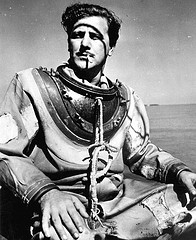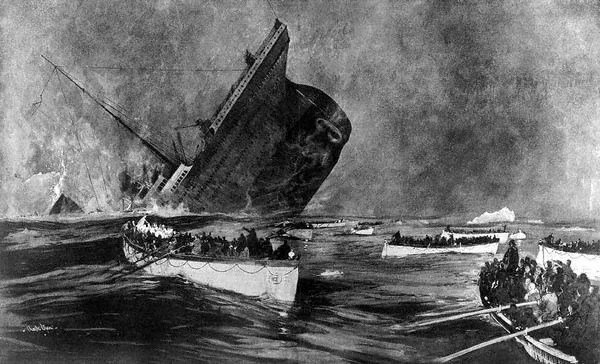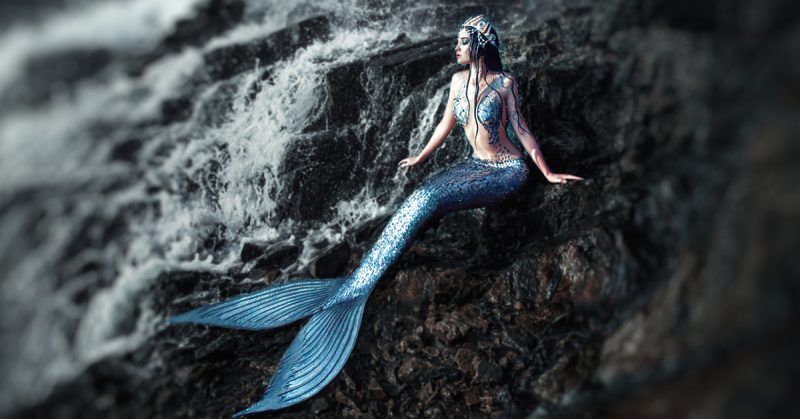Originally published @ Scuba Scoop 8 February 2012
The debonair diver strikes a Hollywood pose in his patched canvas wetsuit, hands resting on either knee, head cocked, with a cigarette dangling from his lips.
For 52 years he was known simply as “the Sponge Diver” in a black-and-white photograph published in National Geographic magazine.
Then in April, Evelyn Gonatos Lange saw the portrait published in the Tribune alongside a story about the state archives putting its old Florida photographs online.
“Nice picture,” Gonatos commented at the Flickr Web site. “It’s my Dad!!! JOHN M. GONATOS.”
Cousins in Tarpon Springs called her sister in Tallahassee: “That’s your dad, that’s your dad!”
Even former neighbors recognized the charismatic jack-of-all-trades. Within the week, the Florida State Library and Archives would set the record straight. The diver officially has a name now. And he has a story.
“He’s the one that really put Tarpon Springs on the map,” said daughter Denise Gonatos Smith.
John Michael Gonatos was a tireless supporter of the local Greek community, but he dreamed of becoming a movie star. With an Errol Flynn likeness, he easily snagged bit parts in five feature films and forged a lifelong friendship with director Elia Kazan that all but guaranteed more work.
But when Hollywood beckoned once more, Gonatos chose family over fame. A devoted husband and father of three, he already had the role of a lifetime.
‘The Golden Greek’
“Family always came first,” recalled Denise Gonatos Smith, a 66-year-old teacher and artist living in Tallahassee.
Her father’s love affair with film began in 1939 when he used a 16-millimeter Bolex to shoot the documentary “Story of the Sponge.”
The 20-minute color movie shows the harvest of sponges from the Gulf of Mexico and features Gonatos, then 26, and his father, a portly Greek immigrant and captain of the boat Evdokia.
Gonatos even filmed divers underwater searching the murky sponge banks.
“He was a pioneer in the movie industry,” said Gonatos’ son, Michael, referring to the underwater scenes.
Ever-resourceful, John Gonatos took his camera to an uncle who made a metal cover for it. When he needed an aerial scene, he climbed the Tarpon Springs water tower. Once the film was complete, he wrote a script and sent it to a professional narrator in New York.
The movie became a regular feature for tourists, who paid 50 cents to watch it at the family’s Olympic Shop on Dodecanese Boulevard.
Gonatos was just as much an attraction. In his youth, he had been a standout high school athlete and nationally recognized boxer known as “The Golden Greek” because of his fair skin, blue eyes and light auburn hair.
“He was extremely handsome,” said 62-year-old niece Maria Fellios of Clearwater Beach. “The girls used to swoon over him.”
Even after he married Virginia, the love of his life, and the woman who could keep him grounded as he pursued his passions.
His movie-star looks and dramatic flair when speaking or telling stories attracted directors, who saw in the young town celebrity an opportunity. Gonatos was a thrill-seeker who commanded an audience.
At 32, he took a part in the 1948 film “16 Fathoms Deep,” the first major Hollywood movie made in Tarpon Springs. It starred Lon Chaney, Lloyd Bridges and Eric Feldary. Gonatos played himself.
The movie chronicled the escapades of Tarpon Springs sponge divers. Not a huge stretch for Gonatos, but it would become his biggest role and whet his appetite for more.
It also allowed the budding actor to befriend Bridges, who reportedly took diving lessons from Gonatos in preparation for the television series “Sea Hunt,” filmed in Silver Springs and other Florida locales.
A taste of the high life
“16 Fathoms Deep” garnered lukewarm reviews; The New York Times applauded the exciting underwater sequences — many featuring the unknown Gonatos — but panned the producers’ attempts at humor.
Still, Tarpon Springs caught the eye of director Elia Kazan, a man proud of his own Greek heritage. He visited and, there along the sponge docks, met the gallant Gonatos. The two became lifelong friends.
Kazan cast Gonatos in two films, including one of the director’s best known, “A Streetcar Named Desire.” The 1951 movie featured Marlon Brando in his second screen appearance and Vivien Leigh of “Gone With the Wind.”
Gonatos piled his family into the old black Buick and headed west for a summer of filming. Until he got paid, money would be tight. So he filled the trunk with sponges, which the family sold at filling stations along the way to help pay for motels and food.
He spent longs days on the set; afterward, the whole family attended swanky Hollywood parties, rubbing elbows with the likes of Brando and Leigh.
“I shook hands with her,” gushed Denise, who was 9.
When her dad played an extra in Kazan’s “Viva Zapata!” a 1952 film starring Brando, all five Gonatoses and two grandparents made the trek. They rented a Spanish-style home at Hollywood and Vine.
“Life was adventurous,” said son Michael, a 70-year-old dental technician living in Tallahassee. “Never dull.”
He remembers driving through the desert on that trip when his dad spied a sign for a nearby dude ranch.
“My father always wanted to be a cowboy,” recalled Michael, who was about 12 at the time. “We went to check it out. I remember my mother was worried we would get robbed.”
Summer came to an end and school had begun when the Gonatoses headed home. It would be the family’s last trip to Hollywood. The children were getting older and Los Angeles’s influences were far different from those of their small Greek hometown. John and Virginia decided it would be best for the girls and their son to finish growing up surrounded by family and heritage.
Gonatos scored two more roles, both in movies being filmed in Florida.
He played a “conch,” a Key West sponge diver, in “Beneath the 12-Mile Reef,” sharing the set with Robert Wagner, Terry Moore and Gilbert Roland. And he sold fishing tackle to Elvis Presley in what would be Gonatos’ last film, “Follow That Dream,” in 1962.
Film lives again
Some 20 years later, he relegated the documentary that started it all to the garage with the other flotsam of those glory days and turned his passion toward local politics. A devastating fungus had nearly wiped out the sponge industry, and Gonatos joined others in the fight to preserve the historical docks and other reminders of the community’s unique history.
He remained a local celebrity throughout his life, autographing calling cards that promoted the “Story of the Sponge” and sported a color illustration of his younger self in diving gear, puffing away on a cigarette. Sometimes he seemed frustrated by missed opportunity in Hollywood; other times, thankful.
“I think he really would’ve been somebody in film,” his niece said. “But he had three wonderful children and a wonderful life.”
The building erected by Gonatos’ father still stands across from what remains of the docks, which are concrete now and hold far more tourists than sponges. The old gift shop is a bakery.
John Gonatos died Aug. 9, 2000, three weeks after Virginia.
Not long after, Denise Gonatos Smith came across “Story of the Sponge” melting in the garage. She had it restored and transferred to DVD, and today, people once again pay to watch it.
“My dad taught us to never give up,” she said. “He always had a dream.”
Researchers Stephanie Pincus and Buddy Jaudon contributed to this report.
Kathy Dowsett







Leave A Comment